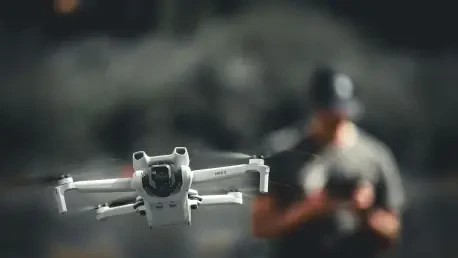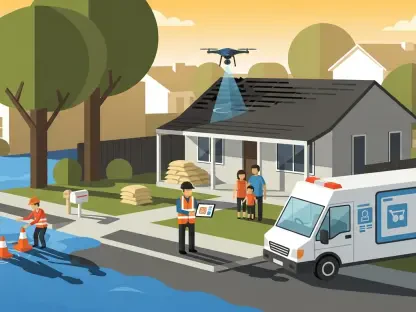In 2025, the insurance industry is undergoing a significant transformation. The decades-old methods of assessing property risk are being superseded by drones and aerial technologies that can determine risk faster, more accurately, and safely. Insurers are using drones to transform roof inspection, survey industrial locations, and natural disaster response. This futuristic technology has now become mainstream. It is a typical data-driven change that professionals should implement to remain competitive. Explore this article to learn all about its role in insurance, implementation challenges, key use cases, and strategies for successful deployments.
A Fast-Growing Market
The drone service market in real estate and insurance is developing rapidly. The worldwide drone services in the real estate industry, which are highly connected with property assessments, were worth approximately $398.9 million in 2023, at an average yearly growth rate of approximately 17.3%.
Data Horizon Research shows that drone roof-inspection tools alone made $1.2 billion in revenue in 2024 and are expected to reach $3.8 billion by 2033, at an annual growth rate of 13.5%.
The drone market specific to the insurance industry is somewhat smaller, approximately $1.1 billion in 2023, but it is projected to grow more than twice to $2.6 billion by 2032, with an average annual growth rate of 10.4%. Also, drones in insurance claims processing and risk assessment are experiencing one of the highest growth rates, with the global annual growth rate projected to be above 20 percent by the end of the second quarter of the 2020s.
With these numbers, it is official: Aerial technology is leaving test stages and is becoming a significant tool in property assessment and risk management.
Why Drones Are Important for Insurance
Speed and Safety
After disasters or severe weather, there are significant threats to the property and human inspectors. Drones can quickly inspect rooftops, facades, and other constructions with minimal risks. First responders have documented up to 75 percent less time spent on assessment during disaster response.
Accuracy and Deepness
Drones have high-resolution cameras, as well as LIDAR or thermal sensors, which collect detailed data on conditions. One application is roof-inspection systems, which can identify missing shingles, structural weakness, or insulation problems-information that was time-consuming or expensive to gather through manual inspection.
Cost Efficiency
With drones, there is no requirement for scaffoldings, specialized equipment, or aerial lifts. The outcome: reduced operational costs by 30 percent through less manual work, traveling, and risk exposure.
Data-Driven Underwriting
Insurers are turning to geospatial data feeds, combined with AI-based detection algorithms, to write policies with unparalleled precision. Telematics and analytics are already being incorporated into the drone insurance market to adjust premiums to the real situation and behavior behind the controls.
Regulatory and Privacy Issues
Increased privacy rights (e.g., GDPR, CCPA) and local laws give insurers strict control over the location and manner of drone operation. It is approximated that 68 percent of drone activities in the United States and the European Union require going through privacy-intensive data acquisition.
Consequently, insurers currently require geofencing and image anonymization, as well as specific consent procedures before implementation.
Real-World Deployment
Drones can provide real-time analytics, with the development of AI, edge computing, and 5G. Thermal imaging, LIDAR mapping, and computer vision provide adjusters and underwriters with actionable information that they can utilize right away.
State Farm has incorporated the use of drones in inspections as a major disaster response strategy. Drones are used to take high-resolution photos of roofs and properties after major storms, and the AI-driven platforms analyze the images. This technology has tremendously reduced assessment times, up to 75%. Other major insurance companies, such as Farmers Insurance and Nationwide, are also embracing the use of drones in daily risk assessment, underwriting, and claims adjustment. The companies are assembling fleets of drones capable of inspecting multi-story houses and industrial rooftops as well as pipelines and high-voltage power lines.
This move to drone technology is assisting in bridging the gaps in coverage and enabling more rapid policy renewals and inspections, with less frequently necessary site visits.
Furthermore, AI-based systems comparing satellite imagery to drone photographs are only aligned some 70 percent of the time. This implies that drones can offer vital granular-level information on the ground that the wider satellite image might overlook.
Challenges & Considerations
Inconsistent regulations are some of the greatest problems that insurers face in the process of adopting drones. Regulations may vary significantly across different regions due to differences in privacy legislation, airspace constraints, and local sentiment, and all these factors influence the way and place drones may be operated with any degree of certainty.
Liability and privacy are also huge concerns. Drone operators must also adhere to rigorous standards of data collection and destruction. Retention of images or other data that could be used to identify individuals can even jeopardize insurance coverage. Consequently, a more significant emphasis on data protection can be seen in insurers adding explicit privacy and cybersecurity measures to their drone insurance policy.
Another great challenge is dealing with huge amounts of data. The more information the drones collect, the more difficult it will be to integrate this new data into the systems of the companies. Discrepancies between drone and satellite data illustrate the need for standardization of data collection processes.
Last but not least, the initial investment may be an actual obstacle to smaller firms. Purchasing drones, data management systems, and educating employees may be costly. Thus, the pay-per-use and on-demand drone insurance models are gaining popularity. They allow business to align their expenditures with their real needs, rather than forcing them to make large investments.
Strategic Recommendations for Business Leaders
Rather than going large-scale at once, a realistic initial move is to begin with pilot programs. Deploying drones on low-risk properties, such as single-family homes or rural locations, can enable insurers to collect data and estimate how much they would save in a controlled environment.
Working with the ecosystem partners is a powerful way forward. Collaborating with specialized drone service firms, AI firms, and legal counsel can allow insurers to expand their abilities rapidly without having to reinvent everything internally.
In order to optimize the utilization of such innovations, it is necessary to introduce clear standards of data governance. This implies establishing a strict standard on data gathering, storage, and anonymization, a practice that does not just protect the rights of the policyholders but also predisposes the generation of more realistic data models.
In addition, firms should invest in workforce training. Ensuring that underwriters, adjusters, and compliance teams have current training, certifications, and continuing education can also promote safety and operational consistency.
Finally, new business models are worth monitoring closely. The increase in popularity of usage-based and pay-per-flight drone insurance plans indicates a radical transformation of the cost structures within the sector, which provides insurers with more flexibility and a method to directly connect their costs with their activity.
In Conclusion
Aerial technologies are more than a passing trend in insurance. It is projected that by the year 2030, unmanned aerial operations will play a critical role in underwriting processes, risk modeling, as well as catastrophe response, particularly in the real estate industry, energy, utilities, and agriculture. Drone liability insurance will adapt to shifting privacy standards in Europe and the U.S. Meanwhile, drone software platforms, which process the feed, will become the accelerator of this ecosystem.
Insurance companies using drones to assess risks and investigate claims are establishing new standards of speed, accuracy, and customer experience. Those who wait will find themselves at a disadvantage, particularly when competitors roll out drone-generated analytics.
The future of property and risk assessment is automated, airborne, and smart. It is not a question of whether to fly or not, but of what rooftops and portfolios to check out first.









